Yeast & fermentation management
1/62
There's no tags or description
Looks like no tags are added yet.
Name | Mastery | Learn | Test | Matching | Spaced |
|---|
No study sessions yet.
63 Terms
What are the most ESSENTIAL things a winemaker wants from a yeast strain?
They must be able to SURVIVE, ADAPT & GROW under conditions such as:
Anaerobic
High sugar (10-15 Bé)
pH below 4.0
Temp range 8-35*C
What are some other things a winemaker wants from a yeast?
Nutritional requirements that allow predictable behaviour and convenient fermentation management
Alcohol tolerance for complete fermentation
Consistent end-product formation under fermentation conditions
In the yeast’s perspective; what must it be able to do?
Increase population from 1-5 × 10^6 cells/mL to 1-2 × 10^8 cells/mL
Accommodate ‘batch’ system design
decline in nutrients
accumulation of toxic end-products
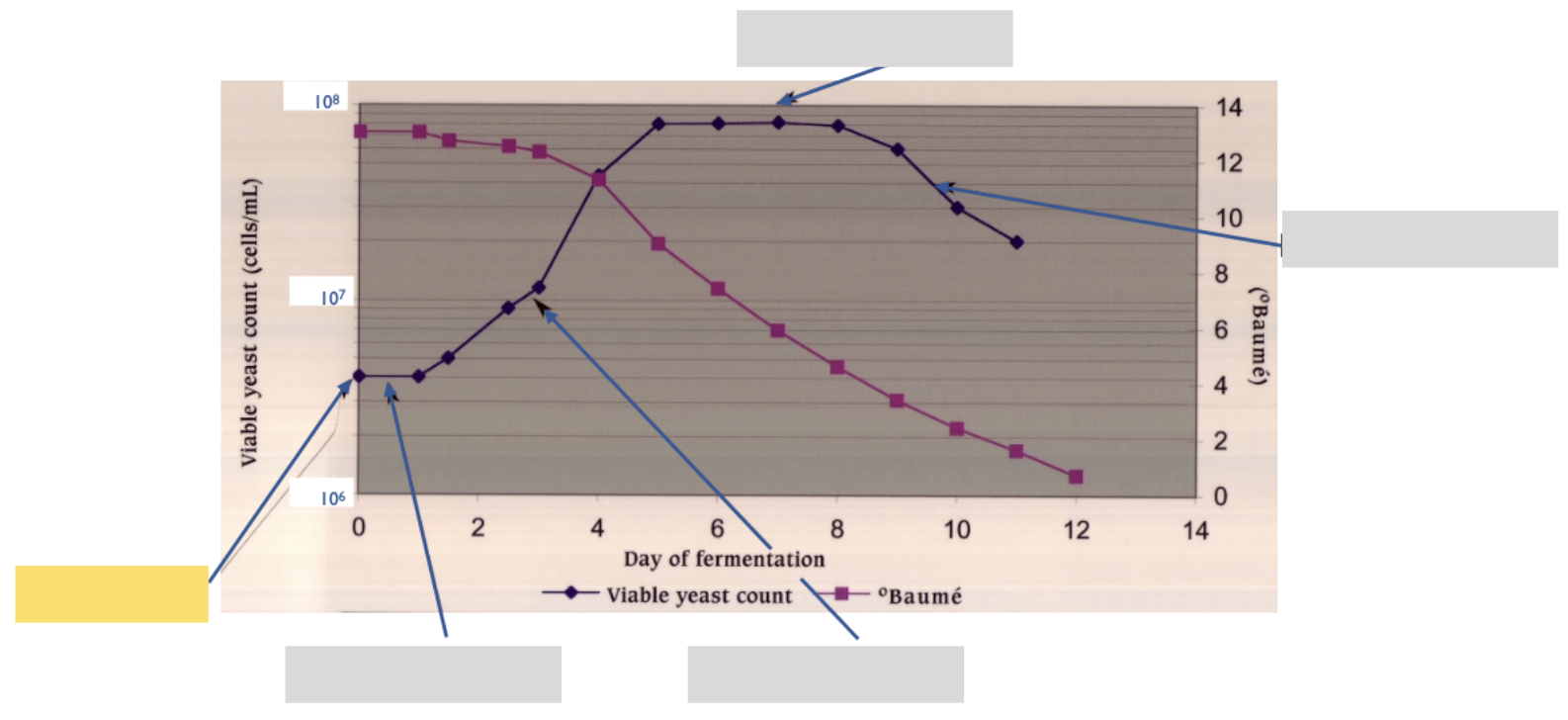
What is the highlighted phase called?
Inoculation
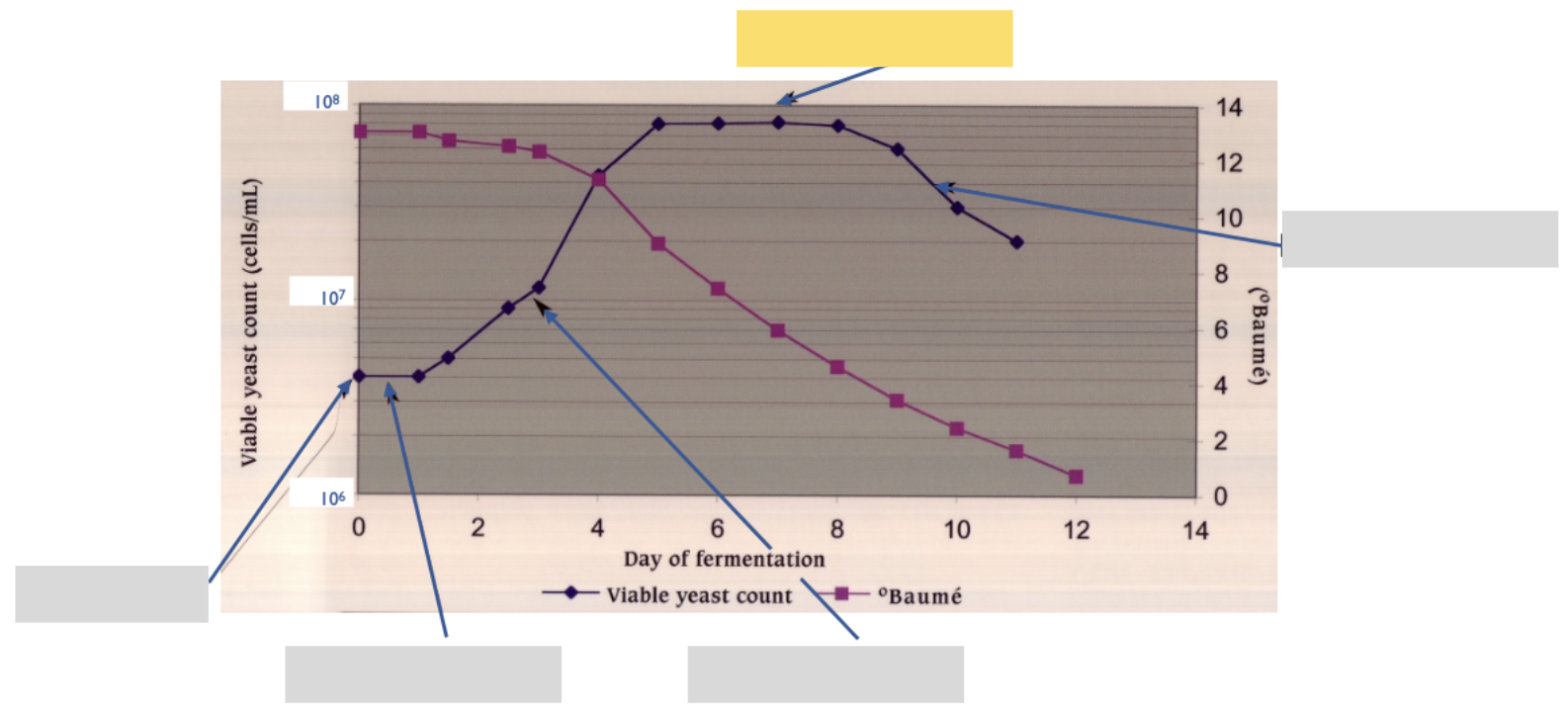
What is the highlighted phase called?
Stationary phase
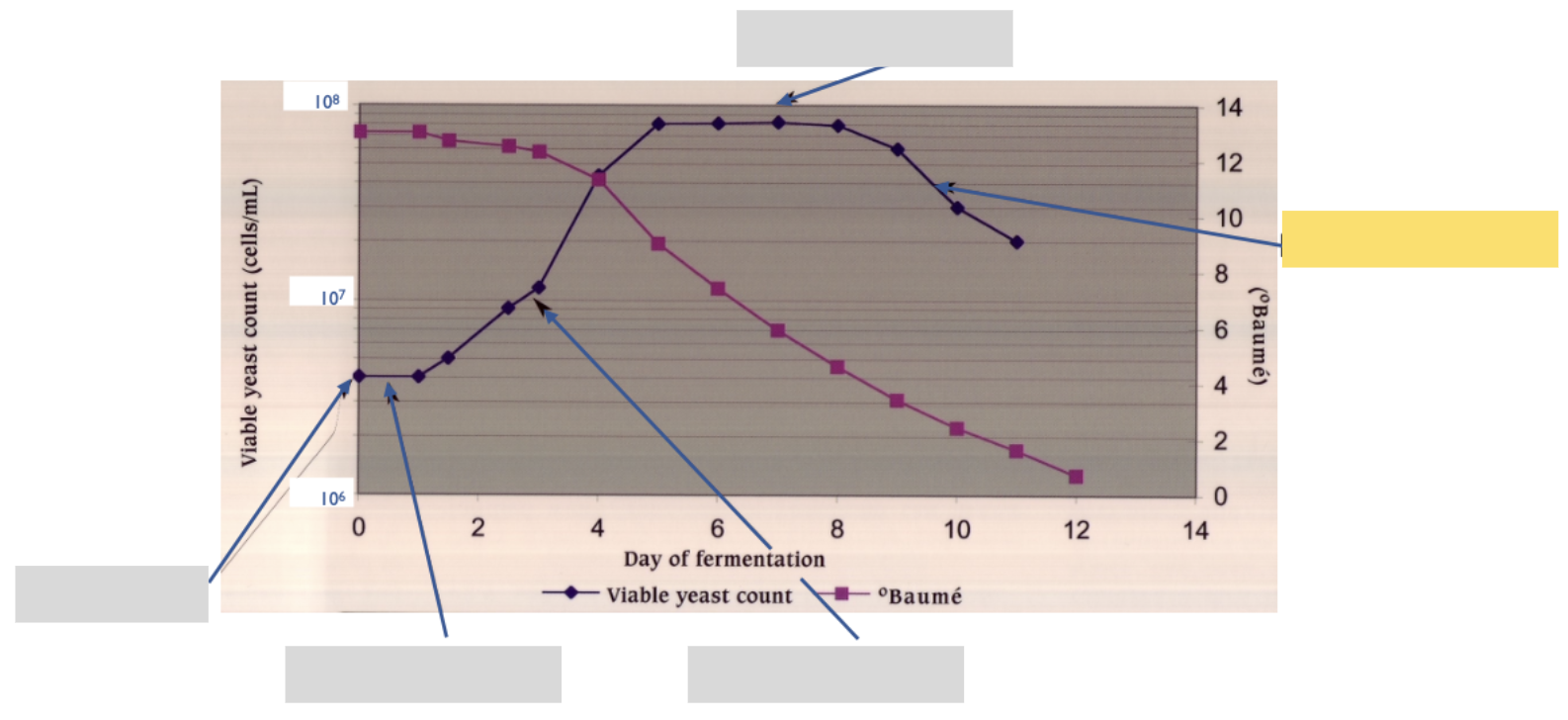
What is the highlighted phase called?
Decline/death phase

What is the highlighted phase called?
Lag phase
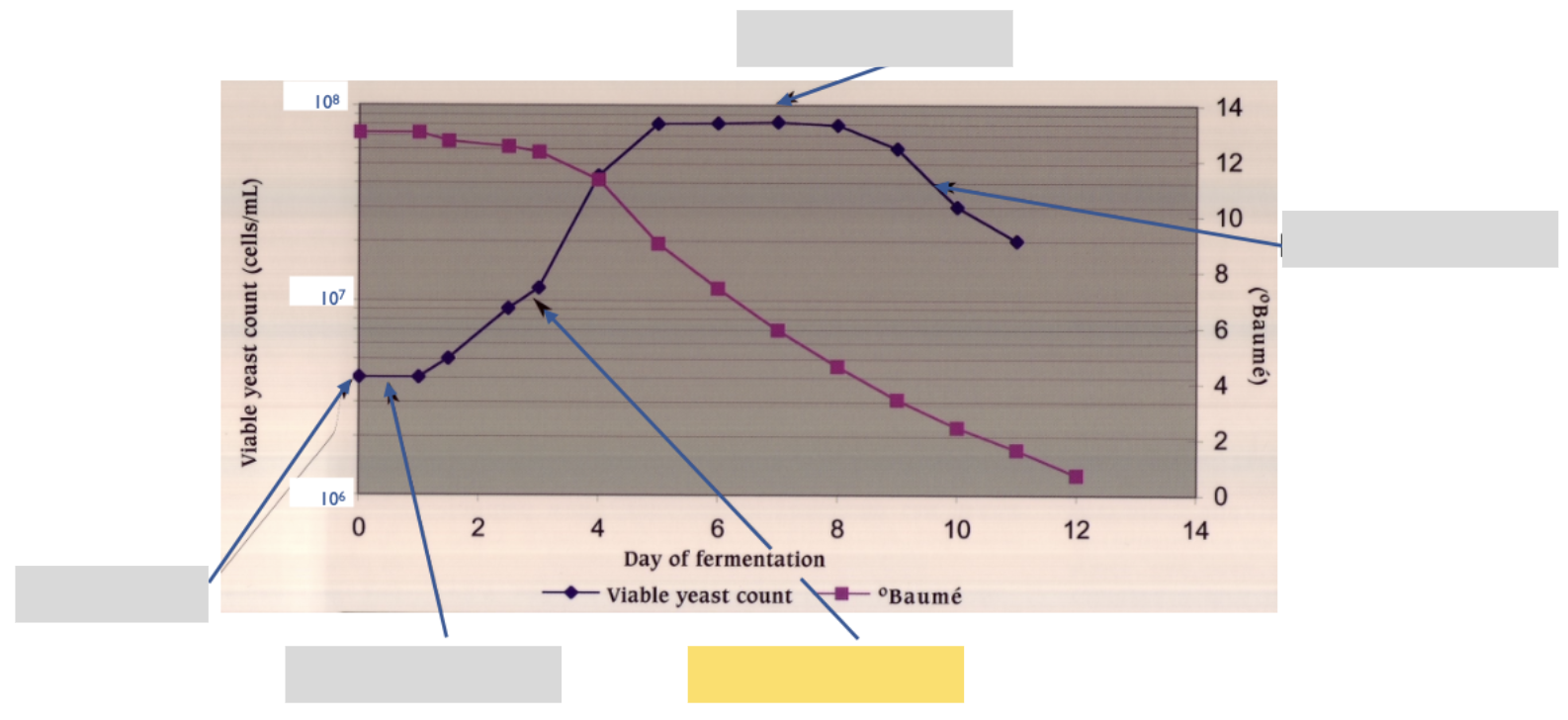
What is the highlighted phase called?
Exponential phase
What is the oenological consideration at the lag phase and decline phase?
To AVOID temperature shocks
What does the lag phase in yeast growth/death involve?
Healthy yeast and gradual environmental transition
Temperature control is difficult in which phase of yeast growth/death?
The exponential phase
What does the exponential phase in yeast growth/death involve?
Heat evolution and sugar transport rate limiting
During the stationary phase it is important to what?
Avoid nutrient limitation
What does the stationary phase in yeast growth/death involve?
Nutrient decrease and end-product build up
What does the decline phase in yeast growth/death involve?
Nutrient exhaustion, ageing/dying population
What can you expect occurs during alcoholic fermentation in terms of yeast populations?
You can expect the yeast population to increase to 1-2 × 10^8 cells/mL
For sugar accumulation in alcoholic fermentation, distinction occurs between two phases. What are the phases and what is the distinction?
Exponential phase: approximately 50% of sugar is directed to biomass and energy production
Stationary phase: near 50% of sugar is directed to energy production and by-product formation without a significant change in cell biomass
What is the exponential phase characterised by and what should you do to support yeast cells/the fermentation?
Characterised by high viability and high budding
do haemocyctometer counts, flow cycometry
do viable/vital staining
What is the stationary phase characterised by and what should you do to support yeast cells/the fermentation?
Characterised by declining viability and budding
do carefully monitor progress of fermentation
do accurately determine residual sugar towards end of fermentation
During the stationary phase, in addition to ethanol and CO2 what are some other metabolic end-products that are formed?
organic acids
higher alcohols
esters
carbonyl compounds
polyols (glycerol)
The theoretical ethanol yield is never realised
200g of glucose makes 102.2g of ethanol and 97.8g of CO2

What are the range and concentration of yeast by-products determined by?
Characteristics of the strain
Wine production steps
Nutritional and physiochemical conditions of fermentation
What features and risks do a indigenous ferment bring?
Add complexity as there will be more than 1 strain working
Risks: extended lag phase - low population to start with
What are some other things you can do to ensure you have selected the correct yeast for your ferment?
Continuing to research:
extending knowledge of yeast behaviour
Yeast performance can be value adding (alternative genera & species)
However:
still experience sluggish/stuck fermentations
How can yeast influence on quality of wine?
Can influence wine in different ways:
be consistent & reliable with minimal impact plus:
can influence grape varietal expression (extracellular enzyme activity) & mouthfeel perception (polysaccharide production)
can contribute via addition of yeast derived flavours (esters etc.)
What are the basic features of a saccharomyces selection?
tolerance to sugar, alcohol, SO2
predictable & controllable (some can be FAST fermenters - research & decide what’s best)
desirable fermentation by-product profile
nitrogen demand (generally need more nutrition than suggested by tech reports)
Desirable characteristics of saccharomyces selection
basic growth factor requirements
high osmotolerance
ability to tolerate SO2
tolerate alcohol produced
minimal production of undesirable by-products
low foaming, ability to flocculate & settle
Yeast performance is dependent on environmental conditions:
physio-chemical
influence of winemaker
Special features of saccharomyces selection
low temp fermentation
beta-glucosidase fermentation aromatics
mouthfeel & phenolic extraction
colour enhancement
compatibility with LAB
Other features of saccharomyces selection
regional & style contribution (e.g., France regions where you are bound to a particular style)
low ethanol yield
killer activity (not sensitive to other yeasts killer factors/toxins)
Why is yeast strain a critical step?
take into account strain characteristics related to wine style
predictable and controllable fermentation at desired temp (fit with refrigeration/control capacity)
predictable nutritional demands
other physio chem limitations
What are some characteristics of non-saccharomyces strains?
typically not able to complete AF
need to over-inoculation with sacch
range of different impacts
bioprotection (grape transport, cold soak, stabulation)
mimicking uninoculated fermentation (early to mid stages of AF
Why might one use non sacch yeasts?
To get a range of different compounds and added complexity - higher costs as you need to buy more than one yeast strain though
What are some important things to note when rehydrating dried yeast?
follow instructions of yeast packet
if you inoculate below 15 degrees - more problems
don’t inoculate with a temp difference greater than 5 degrees
What is ergosterol?
ergosterol is a sterol, a type of lipid, that yeast cells synthesize under aerobic (oxygen present) conditions, essential for maintaining cell membrane integrity and functionality
Why is ergosterol important?
It enhances yeast growth, metabolism and viability during fermentation and improves resistance to stress
What is an example of an easily assimilable form of nutrients for yeast?
Yeast ghosts or hulls
What are some critical factors for inoculation?
temp of water/juice at rehydration can be detrimental to viability
yeast physiological restrictions and nutritional requirements must be respected
addition of complex nutrients
always follow manufacturers recommendations
winery hygiene, microbial/chemical control
forward planning essential
Lower temperature rehydration
need to respect manufacturers instruction
some non sacch need lower temp e.g., 25 degrees
lower temp rehydration protection products can be used (e.g., Lallemand Go Ferm Sterol Flash)
What is critical to the success of a ferment?
Initial nutrient concentration and aeration
fermentation conditions need to support 4-6 yeast generations
completion of fermentation requires yeast numbers of 1 × 10^8 cells/mL
What needs to be done in terms of inoculation if you need to run a quick ferment?
Higher inoculation rate is important
What is assimilable nitrogen in terms of yeast nutrients? And in what form can be added?
It is the second most important macronutrient after carbon
required for amino acid synthesis - proteins
DAP or DIAMMONIUM PHOSPHATE is used for YAN (22% N)
What is DAP addition dependent on?
strain
oxygen availability (i.e., next limiting nutrient)
initial sugar content (i.e., how much work the yeast must do to finish fermentation)
What is the max amount of DAP you can add to a ferment?
Max DAP you can add before exceeding limit is 1700 mg/L
What is minimum N VS maximum N?
Minimum N to complete or maintain fermentation rate
or
Maximum N or Total N used when present in excess
what is the Minimum YAN requirement for low risk fermentation?
Whites – approx. 150 mg/L
Reds – approx. 100 mg/L
What is the YAN requirement for clean/fruity flavour?
Whites – approx. 250 to 350 mg/L
Reds – unknown (research in progress)
What is the Maximum YAN demand?
Mean = 400 mg/L
Range = 330 to 470 mg/L
What are the consequences of nitrogen limitation?
H2S liberated - no action, mercaptan (off aroma/flavour)
sugar transport slows or ceases
hexose permeases irreversibly inactivated
delayed additions may be slow to help
biomass formation limited
fermentation rate is a function of biomass and vitality
FERMENTATION STOPS
What are the key factors in H2S production?
yeast strain genetic propensity (sulphate reduction sequence (SRS) metabolism)
Yeast assimilable nitrogen (YAN) concentration
SO2 (exogenous or derived from the reduction of sulphate) import in yeast SRS metabolism
vitamins )thiamine, pyridoxine, biotin pantothenic acid) are important in yeast SRS metabolism
Generally speak, lower initial N concentration, higher H2S response
Nitrogen additions: how much?
varies according to strain
varies according to composition/conditions
need to know how much is in the juice
measure YAN - YAN = free amino nitrogen + ammonia
routine analysis difficult in terms of:
methodologies and constraints of vintage
easier methods = approximation
historic data helpful
Make an educated guess
Nitrogen additions: timing - earlier additions?
Earlier additions can lead to:
fermentation duration reduced
greater stimulation of fermentation rate
increased cell numbers
NUTRIENT DEMAND HIGHEST AT START OF FERMENT
Nitrogen additions: timing - later additions?
Later addition leads to:
reduced cell numbers
reduced range in fermentation rates
reduced fermentation duration BUT to less extent
Conclusions of nitrogen additions
additions helpful
need a guide - YAN vs yeast requirements, analysis, experience, history
consider timing - moderate initial dose, more later, signals of depletion - H2S, slowing of ferment
What is the average N demand of wine yeast strains?
350 mg YAN/L
What are the recommendations for YAN?
yeast strain plays a critical role
Measure Yan
understand strain N demand and H2S potential
consider timing of DAP additions
DAP additions can also effect flavour outcomes
What are the major grape sugars?
Glucose and fructose
sucrose in low concentration
glu and fru are the major carbon sources utilised by yeast during fermentation
What are importation consideration when it comes to sugars and fermentation?
very high sugar concentrations (>250 g/L) cause osmotic stress - consider this impact for ferment
glucose and fructose are utilised at different rates - can be important in stuck ferments
What happens in sugar consumption during fermentation?
initially grape juice sugar composition ~ 50/50 glu/fru
during fermentation ration glu:fru decreases
if the fermentation sticks, residual sugar is mainly fru
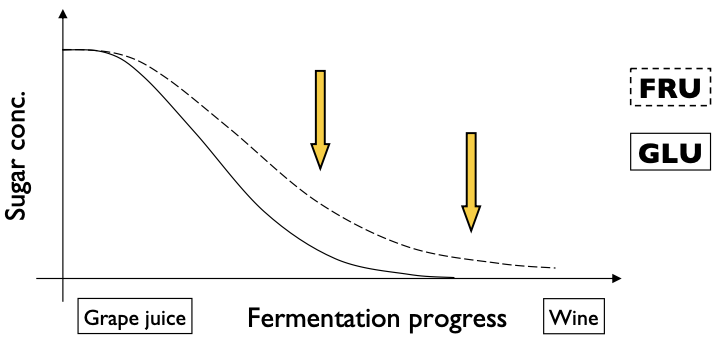
What are the important steps needed to determine the termination of fermentation?
towards end of ferment MUST be diligent in determining end point
necessity for accurate sugar analysis, not just hydrometry
Need residual sugar analysis: enzyme G&F, rebelein etc
once completed (sugar dry <2 g/L), post fermentation processing occurs immediately
further consideration must be given to microbial stability (e.g., SO2 additions for whites, or MLF inoculation in reds)
What are some factors for sluggish or stuck ferments?
excessive clarification of juices/low solids
nutritional deficiencies in juice
strain selection
unsuccessful inoculation
initial temp too low
temp too high
temp shocks, causing cell damage/death
presence of inhibitors (e.g., ethanol, medium chain fatty acids, yeast killer toxins, bacterial contamination and pesticide residues)
During the monitoring of fermentation; what can we measure?
sugar (g & f)
YAN
temp, pH, TA, SO2 - free & total
microscopic observations, cell counts
turbidity
How can one monitor and manage yeast during fermentation? (1)
at inoculation, must/juice temps >15 degrees to minimise yeast viability losses
ferm monitored by measuring sugar content (hydrometer) 1-2x daily, and then determining rate of change in sugar concentration
Need to plot a fermentation curve - helps to manage any problems that arise
How can one monitor and manage yeast during fermentation? (2)
for whites - average 0.5-1 bé/day expected under controlled fermentation conditions
reds ferment much faster due to the presence of skins with reduction on average 1-2 bé/day preferred
cooling should be delayed until about 1 bé of sugar is fermented and avoided once ferment drops to about 2 bé
agitation of the ferment is generally required when cell vitality declines
How does yeast selection influence wine quality?
Yeast selection has several influences on wine quality including:
Aromatic profile
Different strains produce different compounds, including esters (fruity, banana, tropical fruits), higher alcohols (rose), thiols (especially in varieties like Riesling or Sauvignon Blanc)
Fermentation kinetics
Some strains ferment efficiently while others are slower and can develop more complexity
Choosing a strain that is well suited to the must’s pH and sugar is essential in ensuring a clean and complete ferment
Alcohol tolerance and glycerol production
Some strains produce more glycerol – contributing to mouth feel, softness, weight
Strains differ in tolerance to alcohol, osmotic stress, acidity
Volatile acidity and sulphide production
Stress (i.e., nutrient deficiency) can lead to excessive VA or H2S
Nutrient rich ferments or choosing low H2S producing strains can avoid these faults
Malolactic compatibility
Some strains inhibit or support MLF
Important when deciding on MLF timing – sequential or co-inoculation
Style and expression
Neutral strains allow varietal characters to dominate (e.g., EC1118)
Expressive strains can add layers of aroma, or contribute more to mouthfeel